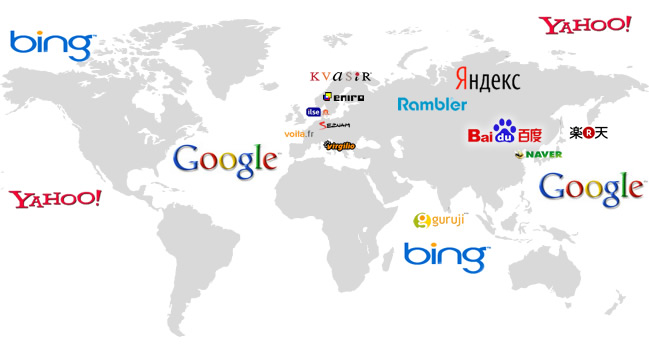A lot of people are interested in international SEO and consider ccTLDs as the proverbial magic bullet to global search success. I would like to clarify Google’s stance on geo-targeting, why ccTLDs may or may not be the best international SEO strategy for your brand, and the role of hreflang in international SEO. Here are 6 common objectives of businesses considering ccTLDs as part of an international SEO strategy.
- We want instant local relevancy
- We want to reduce duplicate content issues
- We want to increase our in-region backlink profile
- We need a completely different marketing strategy in each region
- We want to have multiple domains ranking for the same keyword in each region
- We want to ensure the appropriate URL ranks in regional search engines
Let’s start with definitions. A ccTLD is a country-code top level domain. For example the “es” in www.imawesome.es is the ccTLD for a website in Spain. Now, on the flip side you could have the same website at www.imawesome.com/sp. In this case the TLD – top level domain – is a .com. While the content of the site at .es may be the same as the content of the site at .com/sp, a searcher in Spain may not instantly recognize the latter URL as relevant. So instant local relevancy is something that ccTLDs can help with.
If your brand is struggling to build backlinks because you’re using an erroneous ISO code (like the example above) to geo-target your subdirectory, or potential regional partners have a policy against linking to non-ccTLD domains, then that could be a strong argument for setting up a separate site on a ccTLD. However, depending on your resources, it could just be an argument for buying and 301 redirecting a ccTLD to your subdirectory until you have the resources to launch a full-blown separate site.
But what if your issue is mainly duplicate content? This is not something a ccTLD alone can resolve. For example, say you have a multi-regional site that uses subdirectories to separately target users in Spain, Mexico, Chile, Columbia and Ecuador. All of the content is in Spanish and a lot of it is similar. If you invest in migrating all of those sites to ccTLDs, you will still have duplicate content issues. In addition, you will lose any equity that those sites previously inherited from being on the main TLD and it could take a while before you regain rankings, traffic and revenue, the same as with any site migration.
Now, if you have done comprehensive regional search behavioral analyses and found that your brand needs a completely different marketing strategy, then just based on the fact that you had the money to do such market research you can probably afford the resources to go in the ccTLD direction. So there’s that. And that’s completely fine, as long as you’re aware that it won’t solve your duplicate content issues and other methods of geo-targeting are equally valid in the eyes of Google.
In the long run there are numerous benefits to the ccTLD approach. But the benefits come more from searcher perception of the URL than Google’s actual handling of the URL, because Google is perfectly capable of understanding the geo-target of your site regardless of whether you use ccTLD URLs, a geo-targeted subdomain or subdirectory with gTLD strategy. The “g” in the previous sentence stands for generic. In addition to these approaches Google recommends setting the geo-target for your site in Webmaster Tools and using hreflang for language and regional targeting on a URL level. What Google does not recommend are IP redirects and geo-targeting with parameterized URLs, which are tactics that far too many international websites continue to employ.
If you have no research to justify publishing two completely different sites and your goal is simply #5 above, might I just point out the fact that this is basically spam. I’m not going to sugarcoat it. It’s a strategy employed by brands and marketers to get around Google’s host diversity algorithm tweaks from 2007 up to the most recent Penguin 2.0 update, which addresses multiple pages ranking on the same domain.
Known as “Multiple Domains Crowding” it’s a technique to own more than one top position on first page of Google SERPs for the same search term by several different domains you own or lease. It’s easy for big brands with deep pockets to achieve SERPs dominance by regurgitating the same content across multiple domains. Is it black hat? I say the line is fuzzy at best. But I definitely agree that it makes it difficult for the little guys to win in SERPs and it probably does not provide an optimal experience for searchers. If it’s any incentive for big brands to retire this strategy, I will say the future of Google search is shaping up to look like answer system, e.g. cards, or maybe even a personal assistant e.g. SIRI, instead of lists of results. Focusing on one URL to rule them all is the most forward-thinking approach.
Insofar as getting the appropriate language version of a URL to rank in regional SERPs, this is a clear case for hreflang. Hreflang is a link-element that provides a connection between individual URLs, and only allows Google to “swap out” the URLs from your site currently shown in the search results with ones that are more relevant to the user. It does not affect ranking. It is implemented on a per URL basis and can be used across domains/TLDs.
Before I conclude let me just acknowledge that I’ve offered nothing in the way of Yandex or other non-Google search engines and how they deal with non-ccTLDs. I’ll make it a point to address that in a separate post. I do have one question for SEOs: there’s a strong tendency among SEOs to say that a ccTLD is favored by Google. I personally would be interested in data or at the very least a quote from Google/Matt Cutts to support these claims, because most of what I hear from people in the SEO space sounds presumptuous on this point.
In sum, a ccTLD is a geo-targeting signal only; implementing ccTLDs will not solve the current duplicate content issues due to substantially similar language content, hreflang will. ccTLDs will provide more instant user recognition that this URL is appropriate for the region, and impact rankings. But for any URLs where you intend to keep some level of similar in-language content, regardless of whether you use ccTLDs or another geo-targeting strategy, there is a case for hreflang.

